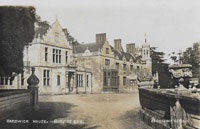|
1913
|
Please click here if you wish to go back to the story of Hardwick before the Great War of 1914-18
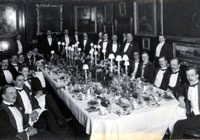
Dinner for 5th and 6th Battalions
|
|
1914
|
On 26th January, 1914, the Honorary Mayor, George Gery Milner-Gibson Cullum, hosted a complimentary dinner to the 5th and 6th Battalions of the Suffolk Regiment at his home at Hardwick House. This picture was kindly supplied by the Reverend Peter Wolton of London, who writes,
"As well as the officers, the following attended: W.Elliott, E.Pritchett, E.S.Bence, E.Jambier Howe and the Mayor, G.M.G Cullum, who hosted it at his home and after whom I now know the road is named.
I just wondered if you could tell me anything about the gentlemen who attended. I am in the process of finding out about the war records of the officers who include my grandfather.
With kind regards
Peter Wolton."
Reverend Wolton later reported that Lieut P C Harris, Lieutenant H O Ashton and Lieut. F W W Attree all died on the Western front, and Captain Ledward was killed in action at Gallipoli in August 1915. Lieutenant H C Wolton served with the 5th Battalion throughout the war and was awarded the MC at the 2nd Battle of Gaza in November 1917. He returned to Bury St Edmunds in 1919 and founded a firm of land and estate agents. (He was the grandfather of the Rev. Peter Wolton.)
You can view the names of those in attendance by clicking on the adjacent thumbnail.
In January 1914, the Suffolk Regiment consisted of the 1st and 2nd regular battalions, (stationed overseas), the 3rd (Special Reserve) battalion, and the 4th , 5th and 6th (cyclist) battalions of the Territorial Force.
By the end of the impending war it would have been necessary to raise sixteen more battalions and the Suffolk Yeomanry would be converted to the the 15th battalion in 1917. The Suffolk Regiment would then consist of 23 battalions at its height.
|
| 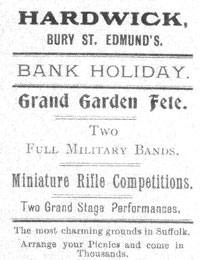
Last 'normal' fete
|
|
blank |
August Bank Holiday Fete, 1914, at Hardwick Heath on the edge of Bury St Edmunds, was a day of merrymaking. The next day, the country was at war. Britain entered the First World War on 4th August 1914, and the regulars and territorials were mobilised. Army reservists streamed into Bury from all over Suffolk.
The 2nd battalion of the Suffolk Regiment consisted of 1000 men, including 26 officers and a medical officer. They had arrived at Le Havre on 17th August, and they were sent straight into the Battle of Mons. Fighting began on 223rd August, and the BEF was forced to retreat south. Just after dawn on the 26th August the Germans caught up with the 2nd Corps of the British army at Le Cateau and the Suffolks mouted a rearguard action under heavy fire. Total British casualties during the battle are estimated at 8,000. Casualties for the 2nd battalion totalled over 700. When they arrived at Pontoise on the 28th August the battalion numbered just 229 men.
Large numbers of wounded men were to quickly overwhelm the existing hospital facilities locally and back in England.
|
| 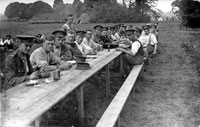
Bury Camp on Hardwick Heath
|
|
blank |
The grounds of Hardwick House were used for training purposes, and the front lawns turned into hay meadows for forage for horses and other animals. Other parts of the estate were farmed for food. Members of the Signals Regiment seem to have been based at Hardwick, and wounded soldiers were often entertained there on days out from Hengrave Hall Hospital.
|
| 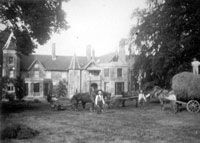
Ornamental lawns turned to haymaking
|
|
1915
|
Hardwick House was not totally commandeered for use by troops, and continued to be the home of George Gery Milner-Gibson-Cullum. The grounds of Hardwick House were used for training purposes, and the front lawns turned into hay meadows for forage for horses and other animals. Other parts of the estate were farmed for food. Members of the Signals Regiment seem to have been based at Hardwick, and wounded soldiers were often entertained there on days out from Hengrave Hall Hospital. Cullum allowed convalescent troops to wander in the grounds of Hardwick House and often invited parties over for tea, as seen here.
In January, 1915, the 1st Battalion Suffolk Regiment sailed from Portsmouth to arrive at Le Havre on January 18th. By February 3rd they were under fire in the Ypres salient.
In France, conditions during the first winter of the war were awful. Both the 1stand 2nd battalions of the Suffolk Regiment spent much of their timein Flanders, defending the Ypres salient. Trenches were feet deep in water, and bombardments and attacks were frequent. Mud was everywhere, and Trench Foot become a familiar condition. The 1st battalion took 300 casualties in two weeks in February when ordered to take some forward positions. The 2nd battalion, holding their lines lost casualties to constant sniper and rifle grenade actions.
The 1/4th Suffolks were in the same conditions. In January they were at Richebourg near Neuve Chapelle. They were Territorials of the 4th Battalion, who had volunteered for overseas service, and were designated the 1/4th to distinguish them from the home based parts of the battalion.
The 1st Battalion of the Suffolk Regiment was virtually wiped out at the Second Battle of Ypres in 1915. The casualties on May 8th were over 400. Of the whole battalion only 30 men returned from the battle for Frezenberg Ridge.
|
| 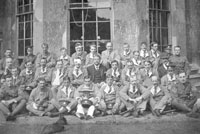
Wounded soldiers with Mr Milner-Gibson-Cullum
|
|
1916
|
Mr Cullum continued to offer hospitality and encouragement to the wounded from various hospitals in and around Bury St Edmunds. Here he is seen seated in the centre of the middle row. Most of the men from hospital are dressed in "hospital blues", the official uniform of convalescent soldiers. These have distinctive collars which show the white lining of the blue uniform.
Cullum ceased farming the Home Farm directly in 1916. He sold off his live and deadstock, and the Home Farm was then let out.
|
| 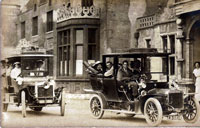
Convalescent soldiers visit Hardwick House
|
|
1917
|
Mr Cullum allowed parties of all classes to visit Hardwick House and its grounds. He particularly welcomed soldiers, whether wounded or on leave.
The Corn Production Act was passed in 1917 to guarantee minimum prices and wages to encourage more home grown food during the war. The government had finally accepted that the German submarine fleet was drastically reducing the country's ability to import food by sea. Indeed it was said that the country was only three weeks away from starvation before food rationing was finally introduced. A new Rationing Scheme was introduced in England on 12th November "to encourage the utmost economy in using food by all classes and all persons".
The first application of the rationing scheme came into force on 31st December, 1917, when sugar went on ration. Sugar would continue on ration until 1920. Other commodities would become officially rationed in 1918.
|
| 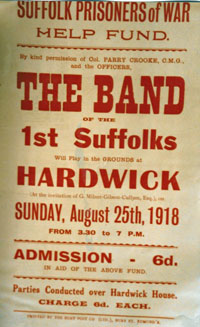
For the benefit of POWs
|
|
1918
|
On the home front, civilians were still feeling the effects of the German submarine blockade. Sugar rationing had been introduced at the very start of the year. Meat, bacon and ham went on ration on 7th April, 1918 and everyone had to register with a butcher. Bacon and ham came off ration on 28th July, 1918, but raw meat continued to be rationed until 15th December, 1919.
Butter and margerine were rationed on 14th July, 1918, along with lard. Lard came off ration in December, 1918. Margerine would still be rationed up to 16th February, 1919, and butter until 30th May, 1920.
|
| 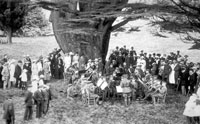
For the benefit of POWs
|
|
blank |
In August in Bury St Edmunds a concert was planned to raise money to help Prisoners of War held in Germany. It was held in Hardwick Park by invitation of George Gery Milner-Gibson-Cullum. Music was supplied by the band of the 1st battalion of the Suffolk Regiment.
Cheered up by the fete, despite the rationing, the 1918 harvest was made extremely difficult by bad weather and a lack of resources. It rained incessantly through August and September. However, agriculture managed to keep the nation fed, helped by the rationing system, and farmers were able to make a living partly because of the price controls imposed by government.
This was also achieved because of a massive input of female labour organised by the Womens Land Army, set up less than a year earlier. The 1918 harvest was the peak of wartime food production. In 1916 the grain harvest was 4.3 million tons. In 1918 it was 6 million tons, despite the weather. In 1918 there were 3 million tons more potatoes raised than in 1913.
|
| 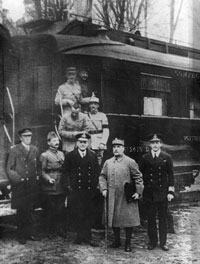
Armistice signed
|
|
blank |
After over 4 years of terrible bloodshed, fighting finally ended with a cease-fire on the Western front at 11.a.m. on the November 11th. The Armistice of 11th November 1918 was actually signed in one of the rail carriages of Marshal Foch's private train at about 5.10 am on 11th November, although talks began here on the 8th November.
By November the influenza epidemic had become a grave problem in Bury St Edmunds. Three wards of the hospital were completely filled by patients with the illness. Eighteen of the first 74 patients admitted died, including one of the hospital nurses.
|
| 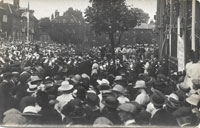
Peace and thanksgiving July 19th, 1919
|
|
1919
|
On July 19th 1919 Bury St Edmunds held its celebrations of the peace, and next day the great Peace Procession was held in central London. This picture comes from the collection of Gerald Brown. It is undated but it is believed to show the July 19th 1919 peace celebration on Angel Hill.
|
| 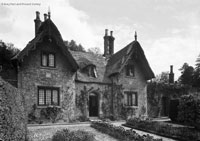
Gardeners cottage
|
|
1920
|
This view of the Gardeners Cottage comes from the Spanton Jarman Collection of the Bury St Edmunds Past and Present Society. This is the position before the estate was put up for sale. This cottage would become the basis of Hardwick manor house after it was extensively enlarged and remodelled by Mr Hewitt in 1927. It was one of the distinctive properties on the Hardwick House Estate built by the Reverend Sir Thomas Cullum who owned the estate between 1831 and 1855. It had a plaque inscribed 'TGC 1837'.
|
|
1921
|
Agricultural policy now lurched away from wartime conditions. The Corn Production (Repeal) Act was passed in 1921 and corn prices plummeted under market conditions as the price control mechanism was removed. The crop yields were also damaged by the almost unparalleled drought of 1921. The government encouraged the import of cheap grain, pork and ham from America. By 1921 about 20% of farms were owned by their occupiers, but most of them found that their income had fallen drastically while the mortgage payments still had to be met. With land producing a much lower income its capital value also fell. From 1921 to 1939 there would be a continual agricultural depression, with low farm incomes, low farm wages, and falling land values.
|
| 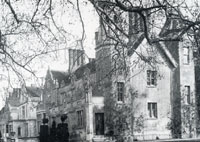
Hardwick House
|
|
blank |
Hardwick Hall and estate had been in the Cullum family since 1656. The Reverend Sir Thomas Gery Cullum, the 8th and last baronet, died in 1855, and the family wills subsequently required the Hall to pass to male relatives only. The last baronet had a daughter whose only son was called George who would be the final holder of the estate. George was unmarried and had no close male relatives. Thus, when as the last squire of Hardwick, Mr George Gery Milner-Gibson Cullum, died on November 21st, 1921, he had no heir who could inherit the estate under the terms of the family trust.
Some of the family collection of books and art-objects and paintings was bequeathed to the town of Bury. It was to become housed at the School of Art in the Traverse, in two years time, following probate. Many of these objects can be seen in Moyse's Hall Museum, the paintings were displayed in the Manor House Museum until it closed, and the books are in the West Suffolk Record Office in Raingate Street, Bury St Edmunds. George also bequeathed a part of the Hardwick Heath to the people of Bury St Edmunds.
The residuary legatee was Mrs Reginald Gurney, who ordered the contents of the house to be sold at auction in June 1924.
The Hardwick estate itself became the property of the Crown, and was put up for sale. In the depression of the time, no buyer could be found for the vast house and grounds still remaining. The estate would therefore be broken up and sold off piecemeal over the next few years. By the end of 1926 it would still prove impossible to sell the great house, which would then be demolished.
|
|
1923
|
George Gery Milner-Gibson-Cullum of Hardwick House, had died in 1921 and left many of his collections to the town of Bury. His books and some of his paintings were now housed in the old School of Art building. It was called the Cullum Reference Library, and would serve as a town library until Local Government reorganisation in 1974. Control then passed to Suffolk County Council, who moved it out in 1983. These books can now be consulted in the West Suffolk Records Office in Raingate Street.
|
| 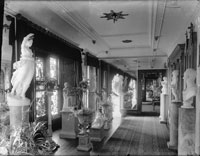
Luxurious contents for sale
|
|
1924
|
George Gery Milner-Gibson-Cullum was the last member of his family to live at Hardwick House. He had died in 1921, and the family trusts and wills had taken some time to sort out. The residuary legatee was Mrs Reginald Gurney, who could inherit the contents of the house, but, because of limitations in the wills, could not inherit the house or estates. Mrs Gurney decided to hold a sale by auction of the contents of Hardwick House in June, 1924. The sale took four days and comprised 1,750 lots of furniture, china, statuary, the painted panelling originally from Hawstead, oil paintings, over 2,000 books, objets d'art and furnishings.
The fine Jacobean painted closet was sold to Christchurch Mansion at Ipswich, and can still be seen there today.
The estates of Hardwick and Hawstead reverted to the executors of George's step-grandmother, Lady Ann Cullum. She had died 45 years earlier, and the failure of the various limitations in her will meant that the property became subject to the Intestate Estates Act of 1884. This resulted in the appointment of trustees to sell the property on behalf of the Crown. In December 1924 the whole estates of Hardwick and Hawstead were put up for sale by the Crown Trustees. Before the auction took place, however, the 1,400 acre combined manors were sold to a Mr Towler.
The sales particulars for the House described two libraries,two drawing rooms totalling 44 feet long and 20 feet wide, dining room, China room, statue gallery and a billiard room. Upstairs had a morning room, seven principal bedrooms with dressing rooms attached, nine bachelor's and smaller bedrooms, and twelve servants bedrooms.
Outside was a winter garden, orangery, peach house and palm house,a range of glasshouses, stabling, a chauffeur's cottage and a riding stable. A clocktower dated to 1851, with a clock by W Nelson Last.
|
| 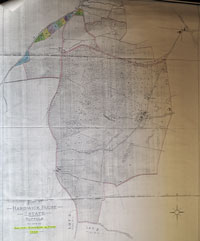
Sales map 1924
|
|
blank |
Mr Towler lost no time in realising his new assets. He immediately offered the sitting tenants their holdings. Hawstead Place farm was bought by William Orbell under this arrangement. A large parcel of the remaining property was put together comprising the Hardwick House, grounds and park, Home farm, Stonebridge Farm, and Horsecroft farm, totalling 726 acres, together with the manor of Grange, and the manor of Hawstead. This auction, held late in December, 1924, attracted a top bid of only £19,000, and the lot was withdrawn. It was then sold privately to John W Greene, the Bury solicitor, probably acting for a client.
Also sold at this time were the separate lots of Hawstead Lodge, the Priory at Babwell at the foot of Tollgate Lane, the maltings on the Mildenhall Road in Fornham all Saints, several cottages and other land. However, large plots of land continued to change hands over the next two years.
|
| 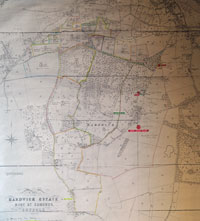
Sales map May, 1925
|
|
1925
|
On 14th May, 1925, Arthur Rutter Sons & Co's advertised sales particulars on the instructions of John William Mitchell of Littleport. He may have been the anonymous client that Mr Greene, solicitor, had acted for in December, 1924. This sale included the house and its 140 acres of grounds. The 140 acres of grounds, sold as lot 4, went to Mr W Orbell, but the house itself was a separate sale. Home farm, Stonbridge farm and Horsecroft farm were sold in individual lots.
A handritten note on the attached plan gives the total area of the Hardwick Estate sale as 726.258 acres. This had been subdivided into 29 lots, unless previously sold privately. Three of the lots were earlier sold privately, lots 2, 3, and 10.
The house was bought by a retired builder, currently Alderman of Sudbury, George C Gooday, who claimed he wanted to renovate the house.
|
| 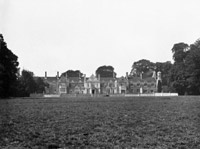
Hardwick House before demolition |
|
1926
|
The 726 acre estate of Hardwick had been put up for sale in 1921 by the crown. The last surviving male heir of the Cullums had died in 1921, and there was no male able to inherit the estate under old family wills. It failed to find a buyer in its entirety, and had been sold off piecemeal over the years since 1921. The last owner of the house, Alderman Gooday of Sudbury, now tried to capitalise on Hardwick House, which he had owned for just a few months.
In November, 1926, Gooday held a three day sale of the fixtures and fittings still in the house. There were 750 lots including 11,000 square feet of oak and pine boarding, an oak staircase, 49 carved mantlepieces of marble and wood, 67 stone vases and figures, six wrought iron gates, 11 greenhouses, and a turret clock by W Nelson last, a Bury clockmaker.
After the sale of fixtures, the fabric of Hardwick House was sold for demolition. All it was thought fit for was to salvage its building materials, such was the depressed state of the economy. The site was to be cleared by August 1927.
The main porch was sold to a Mr Cox for £22.
|
| 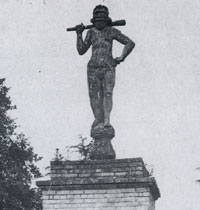
Hercules in 1926
|
|
blank |
One of the objects remaining in Hardwick Park was this statue of Hercules. It had originally been made for the visit of Queen Elizabeth I to Hawstead Hall in 1578. Presumably much restored, it stood at the end of an avenue of lime trees at Hardwick until 1926. It had moved to Hardwick from Hawstead along with the Cullums. Today it stands at Hawstead Place Farm.
|
| 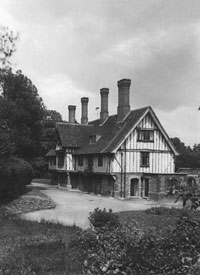
Hardwick Manor
|
|
1927
|
Local timber merchants had bought much of the Hardwick Estate for timber, but had no use for the Head Gardeners house and surrounding gardens on the estate.
A Mr Halford W Hewitt now bought the cottage and some grounds, and now acquired some of the demolition material to build a new Elizabethan styled house which he grandly called Hardwick Manor House. Mr Hewitt was a wealthy financier from Kensington. The new "Manor House" was on the site of the old Head Gardener's house. The Hardwick Manor now included some of the panelling and a staircase from Hardwick House, and the remodelling work was carried out by H G Frost, a local builder. The architects were Kersey, Gale and Spooner. Mr Hewitt employed 11 gardeners to maintain his new grounds.
Seventeen plots of individual building land along Hardwick Lane were also sold at this time. Today, part of the old grounds support the West Suffolk Hospital, and part is public open space, and is known as Hardwick Heath. Home Farm house and Dairy Cottage still stand in Home Farm lane, and the main lodge can still be seen at the entrance to Hardwick Heath car park.
|
|
1934
|
The Hardwick Estate had been owned by the state since 1926, and various attempts had been made to sell it off. On February 5th 1934, some 35 acres of Hardwick Park was now acquired by Bury St Edmunds Borough Council for the sum of £650.
|
|
1939
|
At 11 am on 3rd September, 1939, war was officially declared and the German fleet was reported to be leaving Wilhelmshaven. By 6.30 pm, three aircraft of 149 squadron out of RAF Mildenhall were sent to intercept. Bad weather caused them to turn back.
|
|
1940
|
Please click here if you wish to follow the story of Hardwick into World War II POW Camp, temporary housing, and up to the present day.
|
|
Quick links on this page
Top of page 1914
The Armistice 1918
Last Cullum dies 1921
Hardwick up for sale1924
Final demolition 1927
|
Prepared for this St Edmundsbury website
by David Addy, 21st January, 2022
Books and other resources consulted:
"The History and Antiquities of Hengrave in Suffolk", by John Gage esq., FSA, 1822
"The History and Antiquities of Suffolk, Thingoe Hundred" by John Gage esq., FRS Dir SA, 1838
Excursion to Hawstead - notes by Clive Paine and Philip Aitkens, June 1990, Proceedings SIAH Volume XXXVII, part 3, 1991
"Lost Country Houses of Suffolk" by W M Roberts, 2010.
Moyse's Hall Museum Picture collection
Suffolk Record Office, Bury St Edmunds
| | |


